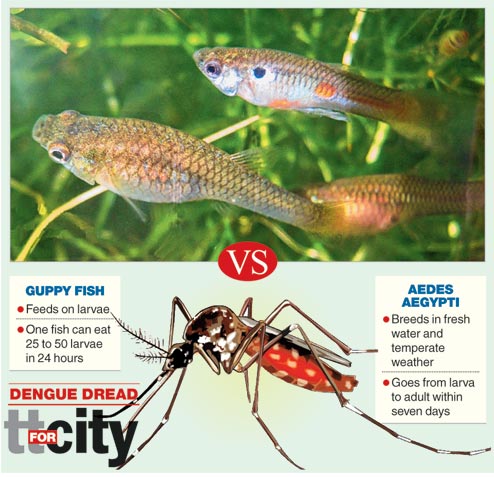A freshwater fish that grows to little more than the size of your index finger is Enemy No. 1 of the Aedes aegypti mosquito that spreads the dengue virus. Metro introduces you to the two-inch guppy that public health experts say is a cheap and effective weapon in the fight against dengue and malaria.
Origin of the name: The fish is named after the British-born naturalist Robert John Lechmere Guppy, who is credited with discovering the species in Trinidad in 1866.
Scientific Name: Poecilia reticulata
Size: Males are typically 0.6 to 1.4 inches long. Females vary between 1.2 and 2.4 inches.
Common habitat: Usually found in small ponds and pools. They also live in brackish water.
Lifecycle: Guppies can live for up to five years.
Aquarium fish: Some strains of the guppy are popular as aquarium fish because they are cheap, not a threat to other fishes, easy to keep and colourful.
Price: Depending on colour, the price for aquarium fish can vary between Rs 5 and Rs 100 for one.

Guppy gulps mosquito larvae: The guppy fish feeds on microbes and mosquito larvae. One guppy fish alone can eat 25 to 50 larvae in 24 hours. For municipalities struggling to destroy breeding grounds of the Aedes aegypti, the guppy's voracious appetite for larvae is a godsend.
Guppy lives where mosquitoes breed: The dengue-causing Aedes aegypti mosquito breeds in fresh, stagnant water. The guppy fish too prefers to live and breed in fresh water.
Study shows guppy's goodness: A trial study commissioned by Cambodia and the Lao People's Democratic Republic and funded by the Asian Development Bank (ADB) and the World Health Organisation has proved that guppy fish can help combat the spread of dengue.
"This is a low-cost, year-round and safe way of reducing the spread of dengue. The whole community can participate in this," the study quotes ADB health specialist Gerard Servais as saying. "It offers a viable alternative to using chemicals and can reduce the scale of costly emergency response activities to contain epidemics."
How Calcutta is using the guppy: Guppies are being released mostly in artificial reservoirs, mostly at construction sites, along with ponds, drains, canals and natural water channels.
Why the guppy can't be reared everywhere: Small containers such as plastic bottles, flower vases, air-conditioner trays and small plastic or earthen pots are unsuitable for the guppy, although Aedes aegypti larvae can easily survive there.
How to procure guppy fish: The municipal health department's office in every CMC ward is supposed to stock guppies and distribute them for free. Also try the Galiff Street market on Sundays, although only the ornamental varieties might be available.
How guppies breed: They can keep pace with the Aedes aegypti mosquito when it comes to breeding. A male guppy will be ready for breeding activity two months after birth while females can breed in three months. If a reservoir has 10 to 20 guppy fishes, after a year the population can shoot up to 2,000!











